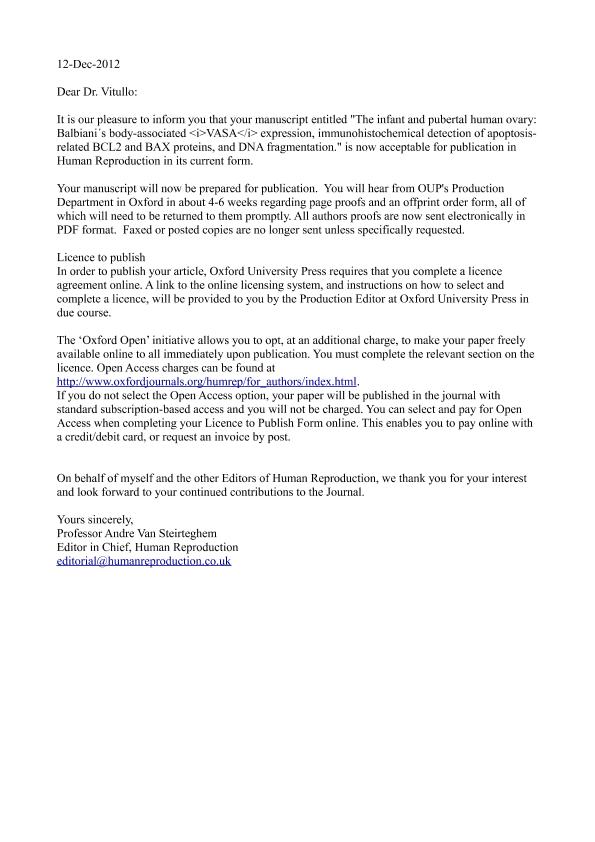Artículo
The infant and pubertal human ovary: Balbiani's body-associated VASA expression, immunohistochemical detection of apoptosis-related BCL2 and BAX proteins, and DNA fragmentation
Fecha de publicación:
03/2013
Editorial:
Oxford University Press
Revista:
Human Reproduction
ISSN:
0268-1161
Idioma:
Inglés
Tipo de recurso:
Artículo publicado
Clasificación temática:
Resumen
STUDY QUESTION: How do apoptosis-related BCL2 and BAX genes, known to regulate death or survival of germ cells in fetal and adult life, and germ-cell-specific VASA protein behave from birth to puberty in the human ovary? SUMMARY ANSWER: In resting primordial follicles in both infant and pubertal ovaries, BCL2 family members and germ-cell-specific VASA behave as in fetal life. After birth, once follicles leave the resting reserve to enter the growing follicular pool, detection of apoptosis-related genes moves from the germ cell to granulosa cells and VASA expression is lost. WHAT IS KNOWN ALREADY: In the human ovary, around 85% of the 7 × 106 potential oocytes produced at mid-gestation are lost before birth, an extra 10% before puberty, and loss continues throughout reproductive life until germinal exhaustion of the ovary. Oocyte loss is mainly driven through a balanced expression of BCL2 gene family members. Apoptosis-inducing BAX gene shows a sustained expression throughout fetal and adult life, whereas apoptosis-inhibiting BCL2 is detectable during the proliferative stage of primordial germ cells and oogonia in the fetal ovary and proliferation of granulosa cells in growing follicles in the adult ovary. The germ-cell marker VASA is detectable in the fetal ovary from early oogenesis and is conspicuously expressed in primordial follicles, where in late pregnancy it is associated with the Balbiani's vitelline space. VASA expression is not detectable in the adult ovary. STUDY DESIGN, SIZE, DURATION: This is a qualitative analysis involving infant/pubertal paraffin-embedded human ovaries screened for apoptosis-related proteins, DNA fragmentation and germ-cell identity. PARTICIPANTS/MATERIALS, SETTING, METHODS: Ovaries from 13 patients ranging in age from 4 to 16 years, undergoing gynaecological surgical procedures due to benign pathology, were studied. Tissues were fixed in 10% formalin, paraffin-embedded and processed for immunohistochemistry to screen the temporal and cellular localization of germ-cell-specific VASA protein and BCL2 and BAX apoptosis-related proteins. In addition, a terminal deoxynucleotidyl transferase-mediated deoxiuridinetriphosphate nick-end labelling (TUNEL) assay was performed to detect DNA fragmentation. General histology and tissue integrity were assessed by haematoxylin–eosin staining. MAIN RESULTS AND THE ROLE OF CHANCE: VASA showed a differential pattern of expression; in the resting primordial follicle reserve in infant and pubertal ovaries, it was associated with the Balbiani's body space in the germ cell. VASA remained detectable in primary follicles leaving the resting reserve, but once follicles entered the growing pool it became undetectable. This pattern of VASA expression is the same as in the fetal ovary. BAX was expressed both in the resting primordial reserve and in the pool of growing follicles, whereas BCL2 was detected only in granulosa cells in antral follicles in the growing pool. Apoptosis-related protein expression moved from the germ cell to the somatic stratum when primordial follicles left the resting reserve to enter the pool of growing follicles, irrespective of female age. Most TUNEL-positive cells were detected in the granulosa cells of antral follicles. No TUNEL-positive cells were found in resting primordial follicles. LIMITATIONS, REASONS FOR CAUTION: The study was limited by the qualitative nature of the immuno-histochemical analysis and the TUNEL assay. The results neither quantify the levels of germ-cell death nor exclude other concurrent cell death mechanisms that could act in the regulation of female germ-cell number. WIDER IMPLICATIONS OF THE FINDING: This study provides missing knowledge about apoptosis and germ-cell-specific VASA expression in the human ovary between birth and puberty and the participation of BCL2 and BAX genes in the balance between death and survival throughout female germ-line development. Intracellular localization of VASA in resting follicles emerges as a possible marker with prognostic value that needs further investigation, especially in infant patients entering ovarian cryo-preservation programmes. This knowledge will be valuable in optimizing the rescue and clinical use of germ cells to restore fertility in women. STUDY FUNDING/COMPETING INTEREST(S): No external funding was obtained for this study. The authors have no conflicts of interest to declare. TRIAL REGISTRATION NUMBER: Not applicable.
Palabras clave:
Human Infant Ovary
,
Vasa
,
Bcl2
,
Bax
,
Tunel
,
Apoptosis
,
Balbiani'S Body
,
Ovarian Reserve
Archivos asociados
Licencia
Identificadores
Colecciones
Articulos(SEDE CENTRAL)
Articulos de SEDE CENTRAL
Articulos de SEDE CENTRAL
Citación
Albamonte, María Itatí; Albamonte, Mirta S.; Stella, Inés; Zuccardi, Luis; Vitullo, Alfredo Daniel; The infant and pubertal human ovary: Balbiani's body-associated VASA expression, immunohistochemical detection of apoptosis-related BCL2 and BAX proteins, and DNA fragmentation; Oxford University Press; Human Reproduction; 28; 3; 3-2013; 698-706
Compartir
Altmétricas




